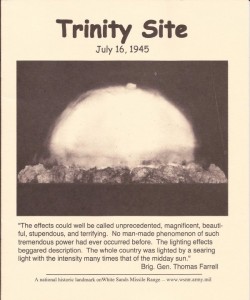
So –Janet and John take a holiday (vacation for my American friends) and where do we go? The middle of nowhere of course…. But not just any nowhere. A radioactive nowhere in the middle of the New Mexico desert.
Last year, while mucking about on the Internet (as one does), I discovered that on two days every year, the US military opens up the White Sands Missile Base to civilians who want to visit the Trinity Site – the place where the first atomic bomb was exploded on July 16th 1945.
That explosion defined the latter part of the 20th Century. I grew up in the shadow of the Bomb (always with a capital B), the Arms Race, the Cold War, the Space Race and the nuclear power debate punctuated by the accidents at Three Mile Island and Chernobyl… and let’s not forget a lot of pulp sci fi.
Of course, I had to go to Trinity.
The day began very early in the morning in Alamagordo (NM) where a convoy formed in the high school football field parking lot – under the watchful eye of local law enforcement. We were in the middle of what must have been a hundred vehicles.
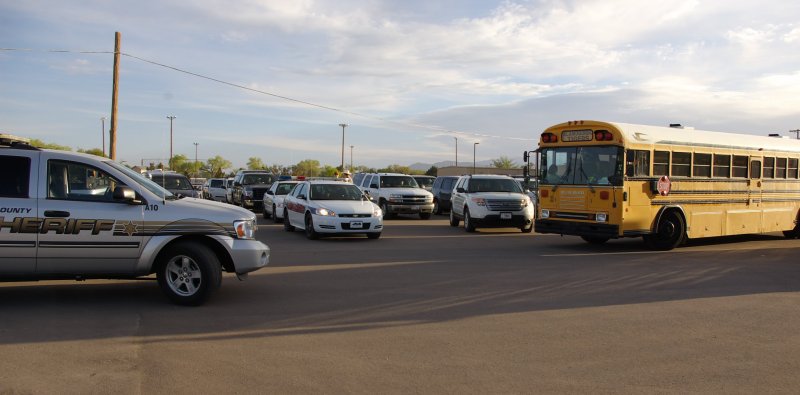
Did our rental agreement with Thrifty Rental Cars cover radiation damage? Too late to worry about that now.
Our escort opened a side gate into the Missile Range and off we went – past any number of fascinating looking government buildings and towers that we had been warned not to photograph.
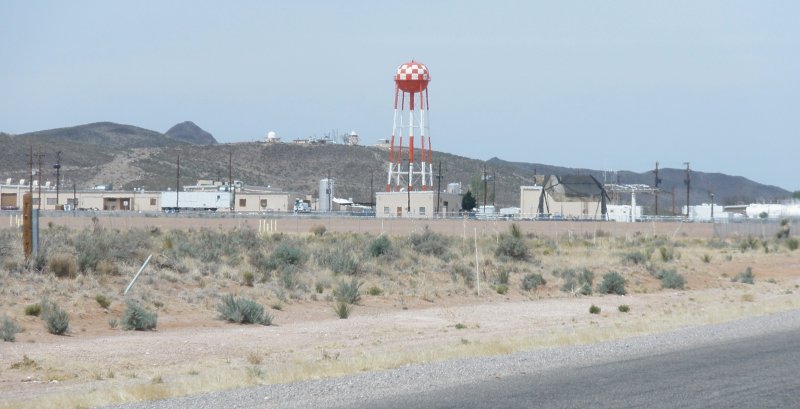
Oops!

The first surprise – Oryx.
Well – Oryx signs. We didn’t see any actual beasts, although we are assured they are out there.
Apparently many years ago, African Oryx were introduced to the Missile Range to provide sport for army hunters. Maybe the hunters were poor shots – because the beasts thrived to the point of almost becoming pests.
They are still hunted (under license), but the closest we got was the warning sign and a few tracks near one of the bunkers.
Trinity is in the northern part of the range – it took almost two hours to drive there – and whatever I might have expected, it wasn’t the almost carnival atmosphere that we found in the car park.

There were hundreds of people – and a constant stream of new arrivals from a second entry point. There were adults with kids and dogs – some had brought picnics. There was food for sale, souvenir t-shirts, music and of course portable ‘facilities’. It a lot of ways it reminded me of a music festival.
Our first stop was the McDonald Ranch house.
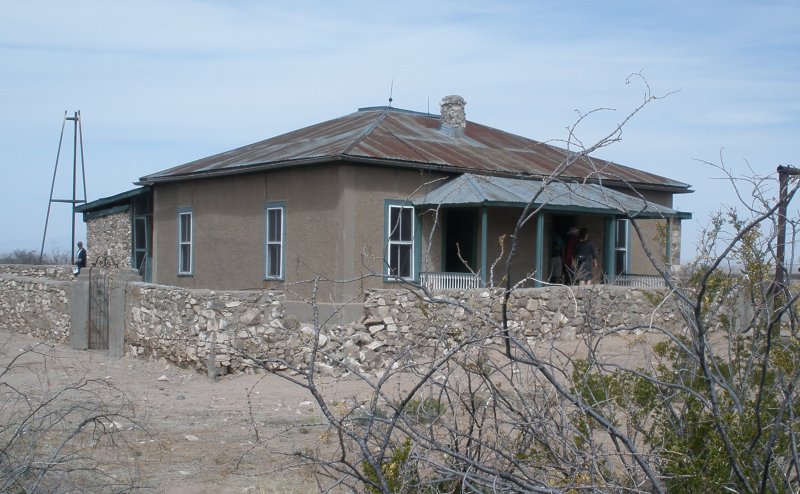
Robert Oppenheimer and his team assembled the “gadget” as it was called in the master bedroom. It was so low-tech! They used plastic taped to the windows to keep the dust out of bomb itself. That doesn’t seem right. The house is just two miles from ground zero – and survived the blast.
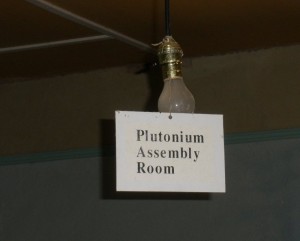
It’s such a humble building to hold such an important place in history.
At the site proper, there is a barely discernible depression – not big enough to be called a crater. In the middle stands a black obelisk – marking the site of the tower from which the bomb was suspended and detonated 100 feet above the ground. All the remained of the tower after the blast was a bit of concrete and a few inches of twisted metal from its base.
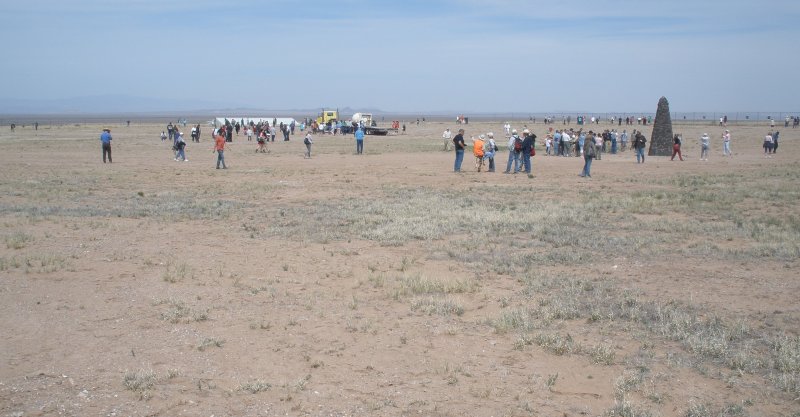
The heat of the blast turned the surrounding desert sand to a sort of radioactive green glass. Most of that has been removed by the government. All over the site are warning signs not to remove any of this ‘trinitite’ – under pain of arrest and imprisonment. That didn’t stop people from looking for it. I did find the tiniest piece – it was really pretty. For a moment I was tempted… but then I realized I had to catch two flights to get home again. I figured my chance of getting a piece of radioactive mineral through two airport scanners was pretty poor! I put it back where it belonged.
The subject of radioactivity was never that far from my mind – but there really wasn’t any need to worry. According to the guide book, radiation levels are just ten times normal – and experts estimate that an hour spent at ground zero gives less radiation than a five hour airline flight.
Of course – I spent more than an hour there, despite the fact that there really isn’t much to see or do. The military had a bomb casing (never used) on display – but I guess the fact that there’s nothing left is what the test was all about.
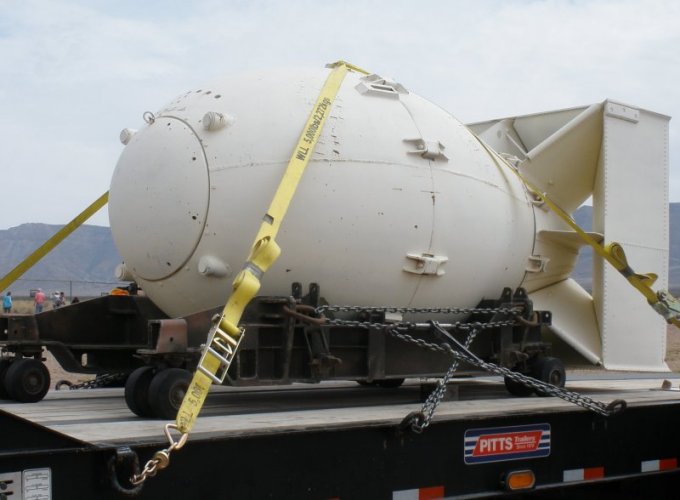
I have also been to the Peace Park in Hiroshima and I wept like a child as I viewed the relics in the museum. The Trinity Site isn’t like that. It’s more factual – figures about heat and energy generated. I found it surprisingly lacking in human emotion. I wonder if that’s because the site is controlled by the military?
After the blast – the man most responsible for it – Robert Oppenheimer – is said to have quoted from an old Hindu text… “Now I am become Death, the destroyer of worlds.” I couldn’t find that quote in the Army’s official guidebook.
I wonder what Oppenheimer would say if he could see the site now on Open Day – with kids and pet dogs, picnics and souvenirs and music.
If nothing else, I think he’d have to agree that it’s a good thing so many people care enough to want to visit a place of such historic importance.
We left the base glad we’d come – but also looking forward to some more cheerful activities.
Come and visit again next week for Chapter Two of this Janet and John book – as we go looking for an even bigger bang.
